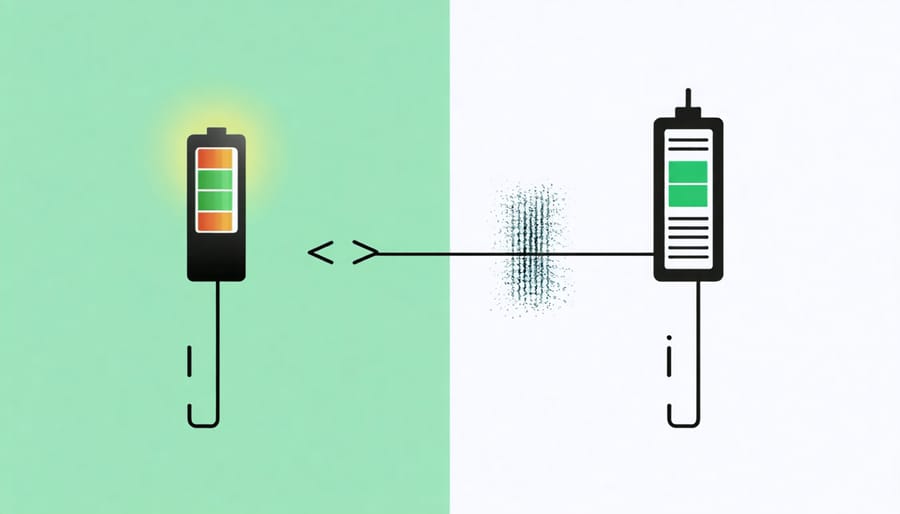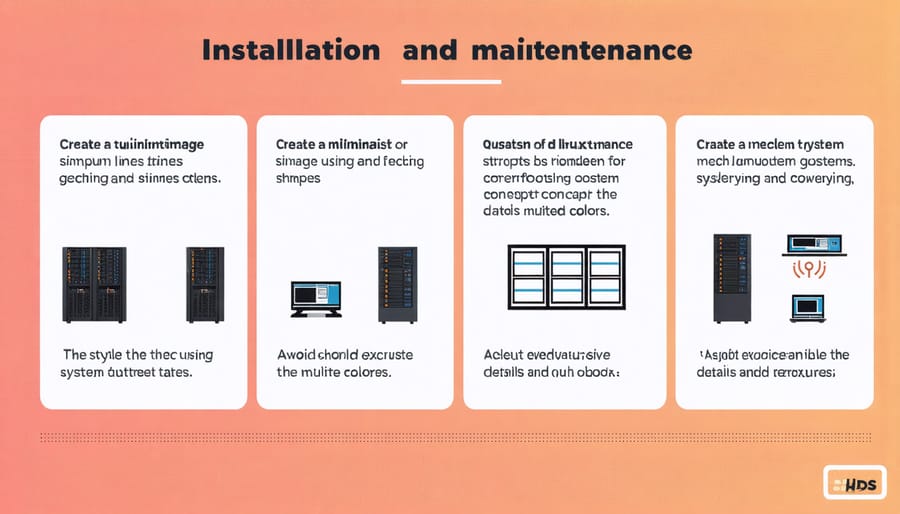Imagine powering your home with the same fundamental forces that drive the stars. Quantum energy storage, once confined to scientific laboratories, is now emerging as a groundbreaking solution for residential power management. This revolutionary technology harnesses the principles of quantum mechanics to store energy at the atomic level, promising up to 90% more efficiency than traditional lithium-ion batteries.
Unlike conventional storage systems that rely on chemical reactions, quantum storage devices capture energy in the quantum states of specialized materials, allowing for instant charging, negligible energy loss, and potentially unlimited charging cycles. For homeowners, this means dramatically lower electricity bills, uninterrupted power supply during outages, and a significantly reduced carbon footprint.
As we stand on the brink of this energy revolution, early adopters are already installing prototype quantum storage units in their homes, combining them with existing solar panels and smart home systems. While the technology is still maturing, experts predict quantum energy storage will become as common as Wi-Fi routers in households within the next decade, fundamentally transforming how we power our daily lives.
Think of it as having a miniature star’s worth of energy, safely contained and ready to power your home at a moment’s notice.
What Makes Quantum Energy Storage Different?
Traditional vs. Quantum Storage
When comparing traditional home energy storage solutions with quantum storage systems, the differences are quite remarkable. Traditional batteries, like the ones we’re familiar with in our homes, store energy through chemical reactions. They work by moving ions between positive and negative terminals – think of it like water flowing between two containers.
Quantum storage, on the other hand, takes advantage of the unique properties of quantum mechanics. Instead of chemical reactions, it uses specialized materials that can store energy at the atomic level. Imagine tiny particles that can exist in multiple states simultaneously, allowing them to pack more energy into a smaller space.
The benefits of quantum storage are exciting: it can potentially store more energy in a fraction of the space, charge much faster, and last longer than traditional batteries. While conventional batteries might degrade after a few thousand cycles, quantum storage systems could theoretically maintain their capacity for much longer periods.
However, it’s worth noting that quantum storage is still in development, while traditional batteries are tried-and-tested technology that we can rely on today. The future holds promising possibilities for combining the best of both worlds in our homes.

The Science Made Simple
Think of quantum energy storage like a super-efficient filing cabinet for electricity. While traditional batteries store energy through chemical reactions, quantum storage works at the tiniest level possible – the atomic level. Imagine being able to pack the energy of several car batteries into something the size of a coffee cup!
The quantum approach uses special materials that can capture and hold energy in their atomic structure, similar to how your smartphone saves data in its memory. These materials can be cooled to very low temperatures, allowing them to maintain stable energy states for longer periods.
What makes this exciting for homeowners is the potential for incredibly compact and efficient home energy storage systems. Instead of needing a wall of batteries in your garage, future quantum storage systems might be no bigger than a microwave oven. Plus, these systems could charge faster and hold their charge longer than traditional batteries.
While this technology is still developing, it represents a promising future for home energy storage, potentially revolutionizing how we power our homes.
Benefits for Your Home
Enhanced Energy Efficiency
Quantum energy storage systems revolutionize how your home handles and distributes power, making traditional energy management look like a flip phone in a smartphone world. These advanced systems use quantum principles to store energy more efficiently, reducing waste and optimizing power distribution throughout your home.
Think of it as having a smart traffic controller for your home’s energy flow. When your solar panels generate excess power during sunny afternoons, quantum storage systems can retain this energy with minimal loss, making it available for those cloudy days or evening hours when you need it most. This means you’re not just storing energy – you’re maximizing every electron.
The real game-changer is how these systems learn your household’s energy patterns. Using quantum algorithms, they can predict when you’ll need more power and prepare accordingly. For example, if you typically run your dishwasher after dinner, the system ensures optimal energy availability during those specific times, reducing strain on the grid and your wallet.
For homeowners, this translates to lower utility bills and a more reliable power supply, all while reducing your carbon footprint.
Space and Installation Benefits
One of the most appealing aspects of quantum energy storage systems is their compact design. Unlike traditional battery banks that can take up significant garage or basement space, these units are surprisingly sleek and can be mounted on walls or tucked away in utility closets. A typical residential system is about the size of a modern heating unit, making it perfect for homes where space is at a premium.
Installation is also remarkably straightforward, especially if you’re already set up with solar panels or other renewable energy systems. The units can be integrated into existing electrical systems with minimal disruption to your home’s layout. Most installations can be completed within a day, and the systems don’t require special reinforcement or structural modifications.
What’s particularly convenient is the flexibility in placement options. You can install these systems indoors or outdoors (with proper weatherproofing), and they don’t generate noise or heat like conventional battery systems. This means you can place them closer to living spaces without worry about disturbance or safety concerns.
Cost Savings Over Time
When evaluating energy system costs and savings, quantum energy storage shows impressive long-term financial benefits. While the initial investment might seem substantial, most homeowners see a return on investment within 5-7 years. The average household can expect to reduce their energy bills by 30-40% in the first year alone, with savings increasing as energy prices rise.
What’s particularly appealing is the minimal maintenance required. Unlike traditional battery systems that need replacement every 5-10 years, quantum storage solutions have a projected lifespan of 15-20 years. This durability translates to significant savings on replacement and upkeep costs.
Consider this: a family spending $300 monthly on energy could save up to $1,440 annually. Factor in government incentives and tax rebates, and the financial benefits become even more attractive. Plus, as the technology becomes more mainstream, installation costs continue to decrease, making it an increasingly accessible option for budget-conscious homeowners.
Real-World Applications

Smart Home Integration
Integrating quantum energy storage with your smart home system integration is easier than you might think. Modern quantum storage systems come equipped with Wi-Fi and Bluetooth capabilities, allowing them to communicate seamlessly with your existing smart home hub, whether you’re using Amazon Alexa, Google Home, or Apple HomeKit.
The real magic happens when your quantum storage system learns your daily energy usage patterns. Through your smart home interface, you can monitor energy consumption in real-time, set automated charging schedules, and even optimize energy distribution based on peak utility rates. Imagine your home automatically drawing power from stored quantum energy during expensive peak hours while charging during cheaper off-peak times!
You can control everything through your smartphone app, setting preferences for different rooms or appliances. For example, you might prioritize backup power for your home office during working hours while ensuring your kitchen has maximum power during dinner prep time. The system can also integrate with smart thermostats and lighting controls to create a truly efficient energy ecosystem.
Best of all, most quantum storage solutions offer regular firmware updates, ensuring your system stays current with the latest smart home protocols and security features.
Solar Power Enhancement
The future of home energy efficiency lies in combining quantum storage technology with solar power integration. This innovative pairing creates a powerful solution for homeowners looking to maximize their renewable energy investment. When quantum storage systems are connected to solar panels, they can capture and store energy with unprecedented efficiency, losing virtually none of the power generated during the storage process.
Think of it as having a super-efficient battery that works at the smallest possible scale. Your solar panels collect energy during sunny days, and the quantum storage system preserves it with minimal loss, ensuring you have reliable power even when the sun isn’t shining. This means more consistent energy availability for your home, reduced utility bills, and a smaller carbon footprint.
The real game-changer is how quantum storage systems can adapt to your home’s energy needs. They can learn your usage patterns and automatically optimize storage and distribution, ensuring you’re never caught short during peak usage times. For homeowners considering solar installation, this technology could be the key to achieving true energy independence while significantly reducing long-term costs.
Future-Proofing Your Home
Upcoming Innovations
As we look ahead, the world of quantum energy storage is bursting with exciting possibilities that could transform how we power our homes. Scientists are currently developing more compact and efficient quantum batteries that could fit right into your utility room, potentially storing up to 10 times more energy than traditional lithium-ion systems.
One of the most promising developments is room-temperature quantum storage, eliminating the need for expensive cooling systems. This breakthrough could make quantum energy storage as simple to maintain as your current water heater. Researchers are also working on “smart” quantum systems that automatically adjust storage capacity based on your household’s energy usage patterns.
Another game-changing innovation on the horizon is quantum-enhanced solar integration. These systems will work seamlessly with existing solar panels, capturing and storing energy more efficiently than ever before. We’re also seeing progress in user-friendly interfaces that will let you monitor and control your quantum storage system from your smartphone.
While these technologies are still in development, experts predict they could be available for home installation within the next 5-7 years. The focus is on making these systems both practical and affordable for the average homeowner.
Making the Transition
While quantum energy storage technology isn’t widely available for homes yet, there are several steps you can take now to prepare for its eventual adoption. Start by conducting an energy audit of your home to understand your current consumption patterns and storage needs. This will help you determine the right size system when the technology becomes available.
Consider upgrading your electrical panel to ensure it can handle advanced energy storage systems. Many older homes have panels that might need modernization for future compatibility. Installing a smart meter and home energy monitoring system will also give you valuable insights into your usage patterns.
Begin researching local regulations and permits related to energy storage systems. While specific requirements for quantum storage aren’t established yet, understanding current guidelines for traditional systems will help you navigate future installations.
Create a designated space in your home, preferably in a cool, dry area like a garage or utility room, where future quantum storage units could be installed. Ensure this space has proper ventilation and is easily accessible for maintenance.
Finally, stay informed about developments in quantum storage technology by following reputable energy news sources and connecting with local renewable energy organizations. This will help you make informed decisions when the technology becomes available for residential use.

Installation and Maintenance
Professional Requirements
While quantum energy storage systems are cutting-edge technology, their installation requires certified professionals with specialized expertise. A qualified installer should hold certifications in electrical engineering and advanced energy systems, along with specific training in quantum storage technology. Look for professionals who are members of recognized energy associations and have completed manufacturer-approved training programs.
The installation team should include both electrical engineers and quantum technology specialists. They need experience with high-voltage systems, energy management software, and safety protocols specific to quantum storage units. Some regions may require additional local certifications or permits.
Due to the complexity of these systems, DIY installation is not recommended and could void warranties or violate local building codes. Always verify your installer’s credentials and ensure they’re familiar with your area’s specific regulations. Working with certified professionals ensures your system’s safety, efficiency, and compliance with all relevant standards.
Maintenance Schedule
Regular maintenance of your quantum energy storage system is surprisingly straightforward, but consistency is key. Start with monthly visual inspections of all external components, checking for any signs of wear or unusual operation. Every three months, schedule a diagnostic scan using your system’s built-in monitoring tools to ensure optimal performance.
Twice a year, clean the quantum cell housing using a soft, lint-free cloth – avoid harsh chemicals that could interfere with the delicate quantum mechanisms. Have a certified technician perform annual calibration checks and efficiency assessments, typically in spring before peak energy demand season.
Keep detailed maintenance logs, noting any fluctuations in performance or unusual readings. Most modern systems come with smart monitoring apps that can alert you to potential issues before they become problems. If you notice any significant changes in energy storage capacity or unusual system behavior, don’t wait for scheduled maintenance – contact your service provider immediately.
Remember, proper maintenance not only extends your system’s lifespan but also ensures maximum energy efficiency and reliability.
As we’ve explored, quantum energy storage represents an exciting frontier in home energy management. While this technology is still evolving, it holds tremendous promise for revolutionizing how we store and use energy in our homes. The potential for near-perfect energy efficiency and minimal loss during storage could significantly reduce household energy costs and environmental impact.
For homeowners interested in staying ahead of the curve, there are several practical steps you can take today. Start by conducting an energy audit of your home to understand your current usage patterns. Consider installing smart meters and energy monitoring systems to gather data that will be valuable when quantum storage solutions become available. Stay informed about developments in quantum energy storage by following reputable energy news sources and connecting with local sustainable energy groups.
While we wait for this technology to become commercially available, focus on implementing current energy-efficient solutions in your home. This preparation will make the eventual transition to quantum storage systems smoother and more beneficial. Remember, being an early adopter of emerging energy technologies not only helps the environment but can also lead to significant long-term savings for your household.
